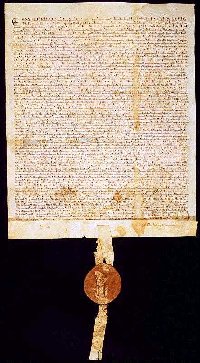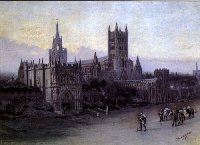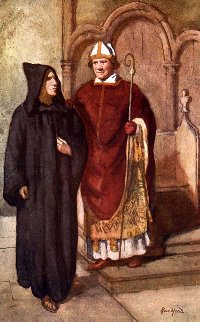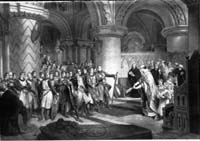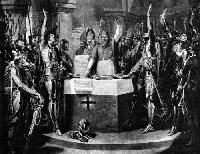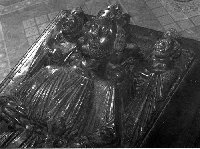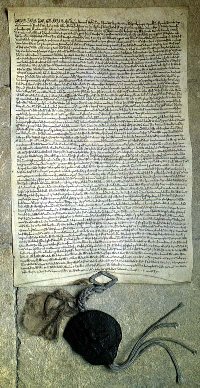John attacked France to regain the lost parts of his Empire. He was stopped in his tracks by a defeat at Les Bouvines, and the cost of this latest French war was to finally goad the Barons into open resistance.
The Barons resented the King's Chief Justiciar, Peter Des Roches, because he was from Poitu, and the Barons decided to see him as a foreigner. But what they really resented was the increased scutage money the king demanded to pay for the war. Scutage was the established method by which those who were liable for feudal military service, could pay a fee to avoid it and stay at home. Had he won the war, the glory and booty resulting would have settled them down, but the Barons were arming their castles in resistance.
On 13th October, according to David Carpenter, King John landed back in England. At about that time, possibly on 19th October, Carpenter suggests that the famous Barons meeting took place at Bury St Edmunds, rather than on the oft quoted date of 20th November. The October date seems to fit in much better with what happened next.
The events concerning the meeting of barons at Bury St Edmunds are considerably muddied by a continuing dispute between the abbey and the king over the election of a new abbot. This post had been vacant since the death of Abbot Sampson in 1211, and the candidates in contention by this time were Robert, the Sacrist, and Hugh de Northwold. Hugh had already been selected for the post by the convent, but rejected by the King. Hugh had even travelled to France to press his case, but was again given the royal brush-off.
By 23rd October, Hugh was back in the Abbey at Bury, and he looked out all of the ancient charters supporting the right to a free election of abbot at Bury. By the 28th October he had taken these to the King in London. The Sacrist and some of his supporters had meanwhile beaten Hugh to reach the King, and by putting their case, had prevented Hugh from getting a favourable response from the King. The King saying, "You have stirred up rebellion against me from which you can expect no good result.... I do not say this with reference to you in particular but on account of certain others as well." This reference may have been to the Archbishop and Bishops who supported the Pope on the issue of free elections, and who favoured the Baronial cause. Carpenter suggests that, in fact, the King was referring to the Barons' meeting at Bury, and that he had heard about it from his supporters.
In November 1214, King John visited the Abbey of St Edmund, and this was recorded in the Electio Hugonis, a detailed chronicle probably written by a monk at the Abbey. This chronicle related to the disputed election of an abbot following Samson's death in 1211 and contains no obvious reference to a gathering of rebellious Barons.
However, the Chronicle of the Election of Hugh does contain veiled references to activities contrary to the King's interests. On 5th November, 1214, the abbey's sacrist, Robert of Graveley, attempted to denounce Hugh of Northwold's activities to the king. The 'Electio' uses these words, as translated by R M Thomson,
"My Lord King, this man assisting you and conducting himself as abbot elect, is working with might and main to deprive you of your royal crown. And unless he is quickly persuaded by the royal provision to abandon this wicked idea, it is to be feared that within a short time he will accomplish what he has already set in motion against the royal dignity."
The Sacrist was personally jealous of Hugh because he had expected to become Abbot after Samson. Nevertheless this would be an extraordinary statement to make about a fellow priest unless Hugh and the Abbey had been involved in some way in the baronial plot.
Hugh's reply to the accusation was to say:
"All cunning and falsity turned in upon itself harms its own lover dreadfully with the blows of its perverse intention. Do you not realise how many others you harm by treating one as near you as your own self with manifest falsehood? For in this you are only wounding yourself, aggravating what you are trying to prevent, just as you are right now. And know this, that over the years I have repeatedly been of more use in all the king's business and realm than you; and I have no intention of letting you get your own way today."
This denial is not exactly as full and wide ranging as one might expect if absolutely nothing at all had been going on behind the king's back. After this exchange, the King left the Abbey and town of St Edmund on his other royal business.
There is no other record of the Barons gathering at Bury St Edmunds except for a detailed account produced some years later at St Albans by another Benedictine monk.
The Bury St. Edmunds connection is related in Flores Historiarum (The Flowers of History), a chronicle written by Roger of Wendover (d. 1236), a monk in the Benedictine monastery of St. Albans.
Unfortunately, Roger is regarded as a rather unreliable historian but in the words of Lord Bingham, Lord Chief Justice, speaking in 1996, "It is not easy to think of a good reason why he should have recorded this story unless he heard it from someone, and not easy to imagine how he came to hear the story if it was entirely false ... there is likely to be at least a germ of factual justification for the story."
The meeting has been attributed to St Edmund's Day, 20th November 1214, but Wendover's account reads as follows:-


